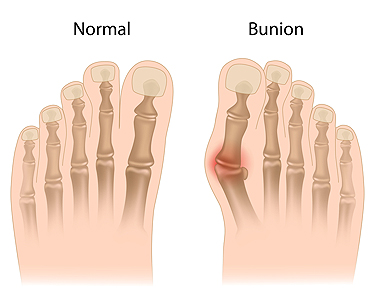Types of Bunions
Monday, 03 August 2020 00:00 A bunion is a bony bump that forms on the joint at the base of the big toe or, occasionally, on the pinky toe. The bunion causes the affected toe to point towards the other toes, instead of pointing straight ahead. Bunions may be painful, making it difficult to walk, stand, wear your typical shoes, or do your usual daily activities. There are two main types of bunions, although many bunions can be a combination of both types. A positional bunion is caused by the joint enlarging as new bone grows. This stretches the outer covering of the joint and pushes the big toe towards the smaller ones, eventually pulling the big toe out of alignment. A structural bunion is caused by the angle between the bone of the big toe and second toe being larger than normal. This can also push the big toe towards the smaller toes. Regardless of the type of bunion you may have, it is recommended that you seek treatment from a podiatrist.
A bunion is a bony bump that forms on the joint at the base of the big toe or, occasionally, on the pinky toe. The bunion causes the affected toe to point towards the other toes, instead of pointing straight ahead. Bunions may be painful, making it difficult to walk, stand, wear your typical shoes, or do your usual daily activities. There are two main types of bunions, although many bunions can be a combination of both types. A positional bunion is caused by the joint enlarging as new bone grows. This stretches the outer covering of the joint and pushes the big toe towards the smaller ones, eventually pulling the big toe out of alignment. A structural bunion is caused by the angle between the bone of the big toe and second toe being larger than normal. This can also push the big toe towards the smaller toes. Regardless of the type of bunion you may have, it is recommended that you seek treatment from a podiatrist.
If you are suffering from bunion pain, contact one of our podiatrists of Advanced Foot & Ankle Associates, PLLC. Our doctors can provide the care you need to keep you pain-free and on your feet.
What Is a Bunion?
Bunions are painful bony bumps that usually develop on the inside of the foot at the joint of the big toe. As the deformity increases over time, it may become painful to walk and wear shoes. Women are more likely to exacerbate existing bunions since they often wear tight, narrow shoes that shift their toes together. Bunion pain can be relieved by wearing wider shoes with enough room for the toes.
Causes
- Genetics – some people inherit feet that are more prone to bunion development
- Inflammatory Conditions - rheumatoid arthritis and polio may cause bunion development
Symptoms
- Redness and inflammation
- Pain and tenderness
- Callus or corns on the bump
- Restricted motion in the big toe
In order to diagnose your bunion, your podiatrist may ask about your medical history, symptoms, and general health. Your doctor might also order an x-ray to take a closer look at your feet. Nonsurgical treatment options include orthotics, padding, icing, changes in footwear, and medication. If nonsurgical treatments don’t alleviate your bunion pain, surgery may be necessary.
If you have any questions, please feel free to contact one of our offices located in Lake Worth and Aledo/Willow Park, TX . We offer the newest diagnostic and treatment technologies for all your foot care needs.
Blog Archives
- April 2025
- March 2025
- February 2025
- January 2025
- December 2024
- November 2024
- October 2024
- September 2024
- August 2024
- July 2024
- June 2024
- May 2024
- April 2024
- March 2024
- February 2024
- January 2024
- December 2023
- November 2023
- October 2023
- September 2023
- August 2023
- July 2023
- June 2023
- May 2023
- April 2023
- March 2023
- February 2023
- January 2023
- December 2022
- November 2022
- October 2022
- September 2022
- August 2022
- July 2022
- June 2022
- May 2022
- April 2022
- March 2022
- February 2022
- January 2022
- December 2021
- November 2021
- October 2021
- September 2021
- August 2021
- July 2021
- June 2021
- May 2021
- April 2021
- March 2021
- February 2021
- January 2021
- December 2020
- November 2020
- October 2020
- September 2020
- August 2020
- July 2020
- June 2020
- May 2020
- April 2020
- March 2020
- February 2020
- January 2020
- December 2019
- November 2019
- October 2019
- September 2019
- August 2019
- July 2019
- June 2019
- May 2019
- April 2019
- March 2019
- February 2019
- January 2019
- December 2018
- November 2018
- October 2018




